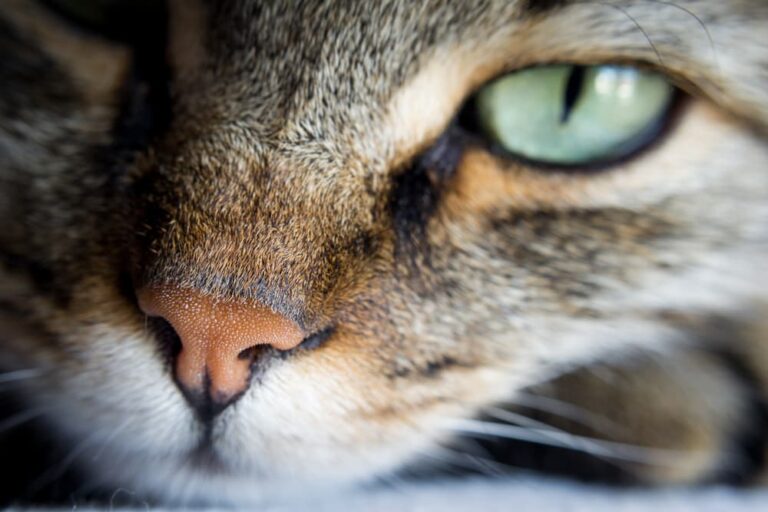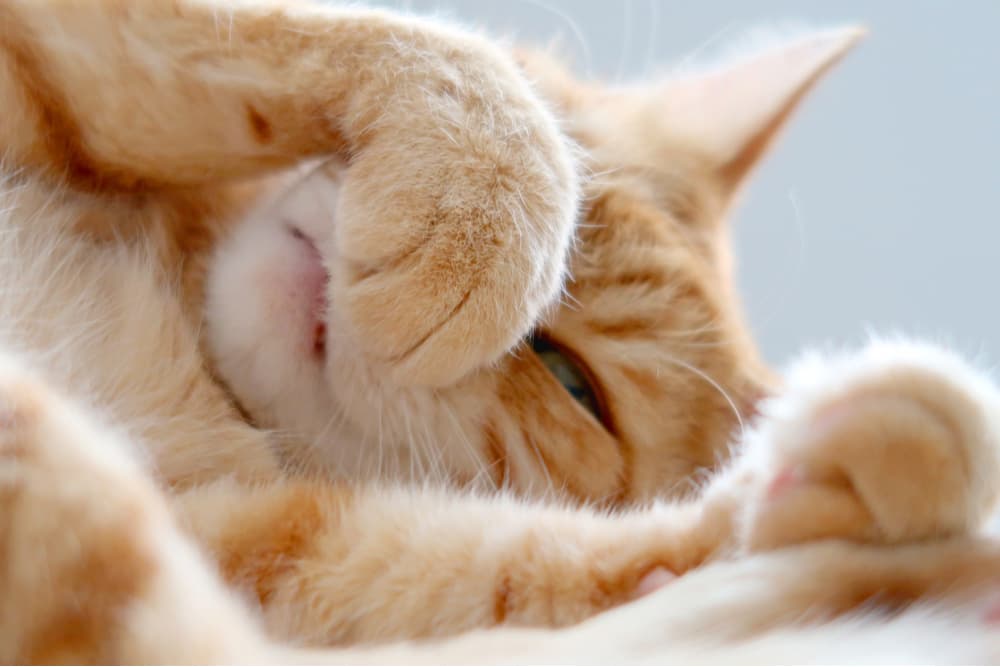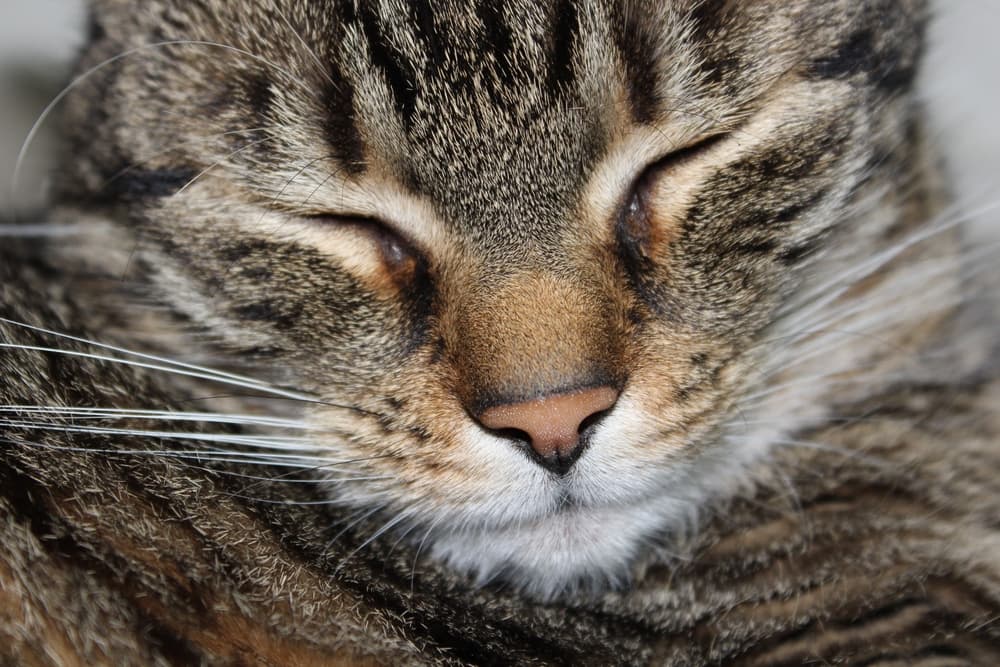Cat Dry Nose: Causes and How to Help

Overview
- Each cat's nose is unique, so not all cat noses have obvious wetness to them.
- When a cat’s nose is dry and cracked or red and raw there are many potential conditions that cause it.
- Any cat with a dry, cracked, irritated nose should be examined by a veterinarian to determine the cause.
- A home remedy that can help some cats with a mildly dry nose is petroleum jelly.
Cat noses are adorable and one of the first things we notice on our cute little kitty’s face. But for some pet parents, the nose appears different. Instead of smooth it might be dry and scaly, appear cracked, or seem red and irritated.
The first thought you may have is if the nose is dry, is my cat dehydrated? A common concern, but cat noses become dry and irritated from issues other than dehydration. Read this article for what your feline’s nose should look like and what could be the cause of dry nose in cats.
Should a Cat’s Nose Be Dry or Wet?

To answer this question, it’s important to realize that each cat’s nose is unique. Some cats have a very wet nose that leaves a small spot of residue after they sniff something. Other cats have no obvious wetness to the nose. There is no hard and fast moisture standard for cat noses, your feline’s nose should never be so dry that it appears cracked, red, scaly or painful.
Cats sweat from very few places on the body—only from hairless areas such as pawpads and possibly the nose. It will make the bridge of your cat’s nose appear wet. This is normal unless your cat is showing symptoms of being overheated, such as breathing with her mouth open, unwilling to move/exercise, and feeling warm to the touch. Keep in mind that cats may sweat more and increase their body temperature in high stress situations like a visit to the veterinary clinic.
Why is My Cat’s Nose Dry?

When a cat’s nose appears dry and cracked or red and raw there are many potential conditions or factors that cause it.
Some cat breeds have particular skin conditions that affect the face. These can result in a dry, crusty nose. Persians, for example, can develop idiopathic facial dermatitis, which causes the facial skin (and nose) to appear dirty. Another breed, Bengals, are known to develop ulcerative nasal dermatitis—inflammation of the nose specifically.
Other potential causes of your cat’s dry nose may include the following health conditions:
Chronic Nasal Discharge
This could occur due to upper respiratory infection (a cat cold) or rhinitis (chronic inflammation of the nasal passages), and would dry out the nose.
Ringworm
Ringworm in cats is a fungal infection that normally affects the face as well as the ears, paws and tail.
Bacterial Infection
Sometimes cats develop an infection that perhaps started with a small wound or accompanies general skin infection.
Eosinophilic Granuloma Complex

This is a condition that usually affects the lips and may extend to the nose. It occurs due to an overactive immune system.
Herpesvirus Infections of the Skin
Herpesvirus (feline herpesvirus-1) is a common virus in cats that causes upper respiratory symptoms like sneezing and eye and nose discharge. Very few cats will develop skin inflammation of the face associated with the virus.
Calicivirus Infections of the Skin
Another relatively common virus in cats that causes upper respiratory symptoms and oral problems like gingivitis (inflammation of the gums) or stomatitis (inflammation of the mouth).
Viral Papilloma
This is a virus that creates firm growths off the skin that can appear crusty.
Lack of Tear Production

If cats aren’t properly producing tears, it could result in a very dry nose, since tears from the eyes connect with and moisturize the nose.
Pemphigus Foliaceus
This describes crusty skin inflammation that typically occurs on the face, especially the underside of the ears.
Keratinization Defect
Although this is rare, this is an issue where a cat’s skin cannot slough dead skin cells appropriately and could potentially result in dry nose.
Cancer
Skin cancer (i.e. squamous cell carcinoma) can cause an ulcerated, red, raw nose in cats.
When to Worry About a Cat’s Dry Nose

Any cat with a dry, cracked, irritated nose should be examined by a veterinarian. A lot of different medical conditions could be the cause, and some get worse over time.
Additional symptoms would give clues that pet parents need to seek veterinary care with more urgency. Symptoms could include:
- Fur loss or crusty skin lesions elsewhere
- Decreased activity (lethargy)
- Decreased appetite
- Eye or nose discharge
How to Treat Your Cat’s Dry Nose

A home remedy that can help some cats with a mildly dry nose would be petroleum jelly or petrolatum skin protectant, which is sold over the counter. As long as it is not a medicated ointment from the doctor, it would not be harmful for your cat to lick it—which she will certainly do!
This can safely be applied several times per day. A thin layer is all that is needed—applying large quantities will not help any more than a small amount.
Drinking more water will not help your cat’s irritated, dry nose.
If your cat is experiencing any other symptoms besides just the nose, or the nose does not improve with petroleum jelly, other treatment is needed depending on the cause.

Your veterinarian may run a couple tests initially such as a cytology, meaning gently brushing the nose and getting a sample onto a slide. If the nose issue is severe or continues after initial treatment, your veterinarian may recommend a biopsy. This consists of placing your cat under anesthesia briefly to take a very small piece of the outer part of your cat’s nose to send to a pathologist (a specialist at examining tissue). The pathologist will be able to provide a lot more information about what is causing the nasal issue.
Common therapies from your veterinarian to treat dry nose in cats may include:
- Topical antibacterial and/or antifungal ointments
- Oral antibiotics
- Oral antiviral medication (i.e. famciclovir in case of herpesvirus)
- Vitamin E (topical or oral)
Related Conditions
- Upper respiratory infection
- Chronic rhinitis
- Ringworm (dermatophytosis)
- Eosinophilic granuloma complex
- Feline herpesvirus-1 (FHV-1)
- Calicivirus
- Mosquito bite hypersensitivity
- Viral papilloma
- Pemphigus foliaceus
- Squamous cell carcinoma









